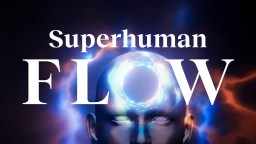Steven Kotler explains the neurochemical changes during flow states that strengthen motivation, creativity and learning. “The brain produces a giant cascade of neurochemistry. You get norepinephrine, dopamine, anandamide, serotonin and endorphins. All five of these are performance enhancing neurochemicals.” Kotler discusses how each amplifies intellectual and cognitive performance.
This is the second video in a five-part series with Steven Kotler on the “optimized brain” available in playlist form here.
Steven Kotler: Besides neuroanatomical changes in flow there are neurochemical changes, right. The brain produces a giant cascade of neurochemistry. You get norepinephrine, dopamine, anandamide, serotonin and endorphins. All five of these are performance enhancing neurochemicals, right. So they make you faster, stronger, quicker and they do the same thing with your brain. In the front end of a flow state you take in more information, you process it more deeply meaning you process it using more parts of your brain and you process it more quickly. There’s some debate about this but it does appear that you process it more quickly. This is norepinephrine and dopamine. So when people enter a flow state they talk about feeling like they’re senses are incredibly heightened. This is the performance enhancing aspect of norepinephrine and dopamine.
Where these chemicals really come in handy is how they affect motivation, creativity and learning. We’ll start with motivation. Besides being performance enhancing chemicals these are obviously all feel good drugs, right. These five chemicals are the most potent feel good drugs the brain can produce. As a result flow is considered the most addictive state on earth. Scientists don’t like the word addictive so instead they use autotelic. When something is autotelic it is an end in itself. What it means is that once an experience starts producing flow we will go extraordinarily far out of our way to get more of it which is why researchers now believe flow is the source code of intrinsic motivation. Another thing that those neurochemicals do is they augment the creative process. So creativity is always recombinantory. It’s the product of novel information, bumping into old thoughts to create something startlingly new. So if you want to amplify creativity, you want to amplify every aspect of that process. Again, the neurochemicals help. So on the front end of the flow state when you get norepinephrine and dopamine they’re tightening focus so you are taking in more information per second. So you are boosting that part of the creative process. Norepinephrine and dopamine do something else in the brain which is they lower signal to noise ratio so you detect more patterns. They jack up pattern recognition so our ability to link ideas together is also an enhancer. Taking in more information we can link it together.
Anandamide which is another chemical that shows up in flow doesn’t just promote pattern recognition. It promotes lateral thinking. So pattern recognition is more or less the linking of familiar ideas together. Lateral thinking is the linking of very disparate ideas together, right. So more information per second, all kinds of pattern recognition, lateral thinking. All of it surrounds the creative process and amplifies all of it which is why, for example, studies run by my organization, the Flow Genome Project, we found creativity is increased 500 to 700 percent. To give you another example in a recent Australian study they took 42 people, gave them a very tricky brainteaser to solve, the kind that needs very creative problem solving. Nobody could solve the problem. They induced flow artificially using transcranial magnetic stimulation to basically knock out the prefrontal cortex. They induced artificial transient hypofrontality technically.
As a result, 23 people solved the problem in record time. So massively amplified motivation, massively amplified creativity. The last thing flow does that’s really important is it jacks up learning. So a quick shorthand for how learning works is the more neurochemicals that show up during experience, the better chance that experience has of moving from short term holding into long term storage, right. Neurochemicals among their many other functions, one of them is to tag experiences. Big neon sign saying really important, save for later because flow is this giant neurochemical dump. It massively amplifies learning. So in studies run by DARPA and researchers at Advanced Brain Monitoring in California, when they introduced flow artificially this time kind of using neurofeedback in soldiers, marksmen to be exact, they found that soldiers in flow learn to shoot 230 percent faster than normal. When they redid this study using novice marksmen, they did it with riflemen and archers, what they discovered is that the period of time it takes to train a novice archer or novice marksman up to the expert level when they’re in flow can be cut in half. So Malcolm Gladwell’s famous 10,000 hours to mastery, what the research shows is that flow cuts it in half.
Directed/Produced by Jonathan Fowler, Elizabeth Rodd, and Dillon Fitton
This is the second video in a five-part series with Steven Kotler on the "optimized brain" available in playlist form <a href="http://bigthink.com/playlists/the-optimized-brain-a-workshop-on-flow-states-with-steven-kotler">here</a>.





